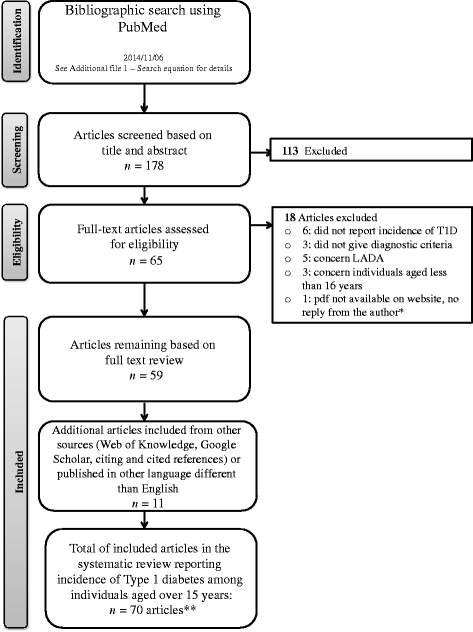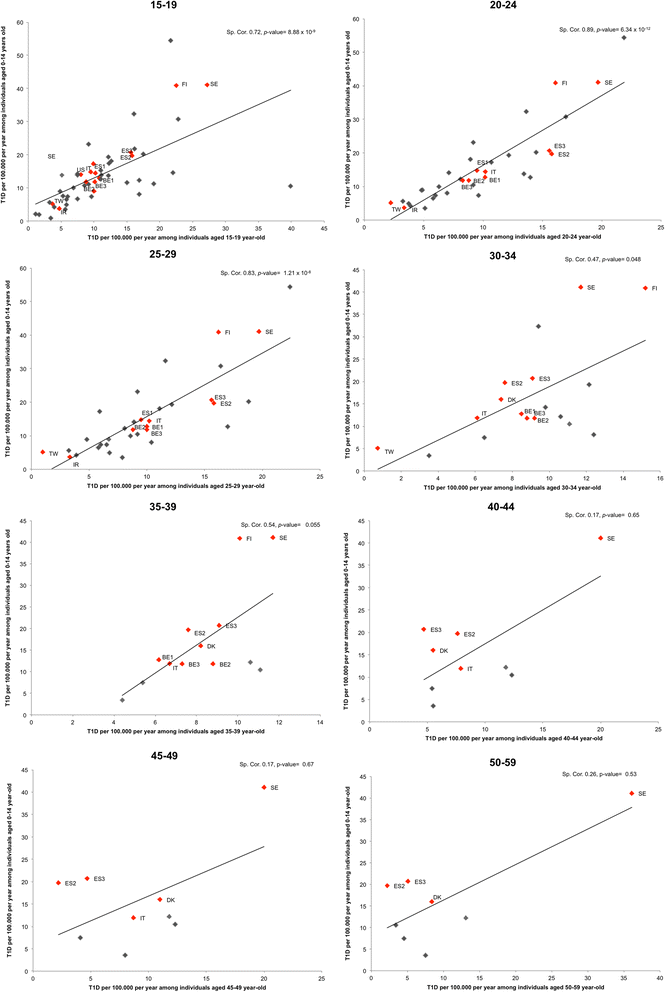Global epidemiology of type 1 diabetes in young adults and adults: a systematic review
- PMID: 25849566
- PMCID: PMC4381393
- DOI: 10.1186/s12889-015-1591-y
Global epidemiology of type 1 diabetes in young adults and adults: a systematic review
Abstract
Background: Although type 1 diabetes (T1D) can affect patients of all ages, most epidemiological studies of T1D focus on disease forms with clinical diagnosis during childhood and adolescence. Clinically, adult T1D is difficult to discriminate from certain forms of Type 2 Diabetes (T2D) and from Latent Autoimmune Diabetes in Adults (LADA).
Methods: A systematic review of the literature was performed to retrieve original papers in English, French and Spanish published up to November 6, 2014, reporting the incidence of T1D among individuals aged over 15 years. The study was carried out according to the PRISMA recommendations.
Results: We retrieved information reporting incidence of T1D among individuals aged more than 15 years in 35 countries, and published in 70 articles between 1982 and 2014. Specific anti-beta-cell proteins or C-peptide detection were performed in 14 of 70 articles (20%). The most frequent diagnostic criteria used were clinical symptoms and immediate insulin therapy. Country-to-country variations of incidence in those aged >15 years paralleled those of children in all age groups. T1D incidence was larger in males than in females in 44 of the 54 (81%) studies reporting incidence by sex in people >15 years of age. The overall mean male-to-female ratio in the review was 1.47 (95% CI = 1.33-1.60, SD = 0.49, n = 54, p = <0.0001). Overall, T1D incidence decreased in adulthood, after the age of 14 years.
Conclusions: Few studies on epidemiology of T1D in adults are available worldwide, as compared to those reporting on children with T1D. The geographical variations of T1D incidence in adults parallel those reported in children. As opposed to what is known in children, the incidence is generally larger in males than in females. There is an unmet need to evaluate the incidence of autoimmune T1D in adults, using specific autoantibody detection, and to better analyze epidemiological specificities - if any - of adult T1D.
Prospero registration number: CRD42012002369.
Figures



References
-
- Borg H, Arnqvist HJ, Bjork E, Bolinder J, Eriksson JW, Nystrom L, et al. Evaluation of the new ADA and WHO criteria for classification of diabetes mellitus in young adult people (15–34 yrs) in the Diabetes Incidence Study in Sweden (DISS) Diabetologia. 2003;46(2):173–81. doi: 10.1007/s00125-002-1021-4. - DOI - PubMed
Publication types
MeSH terms
LinkOut - more resources
Full Text Sources
Other Literature Sources
Medical
Research Materials

